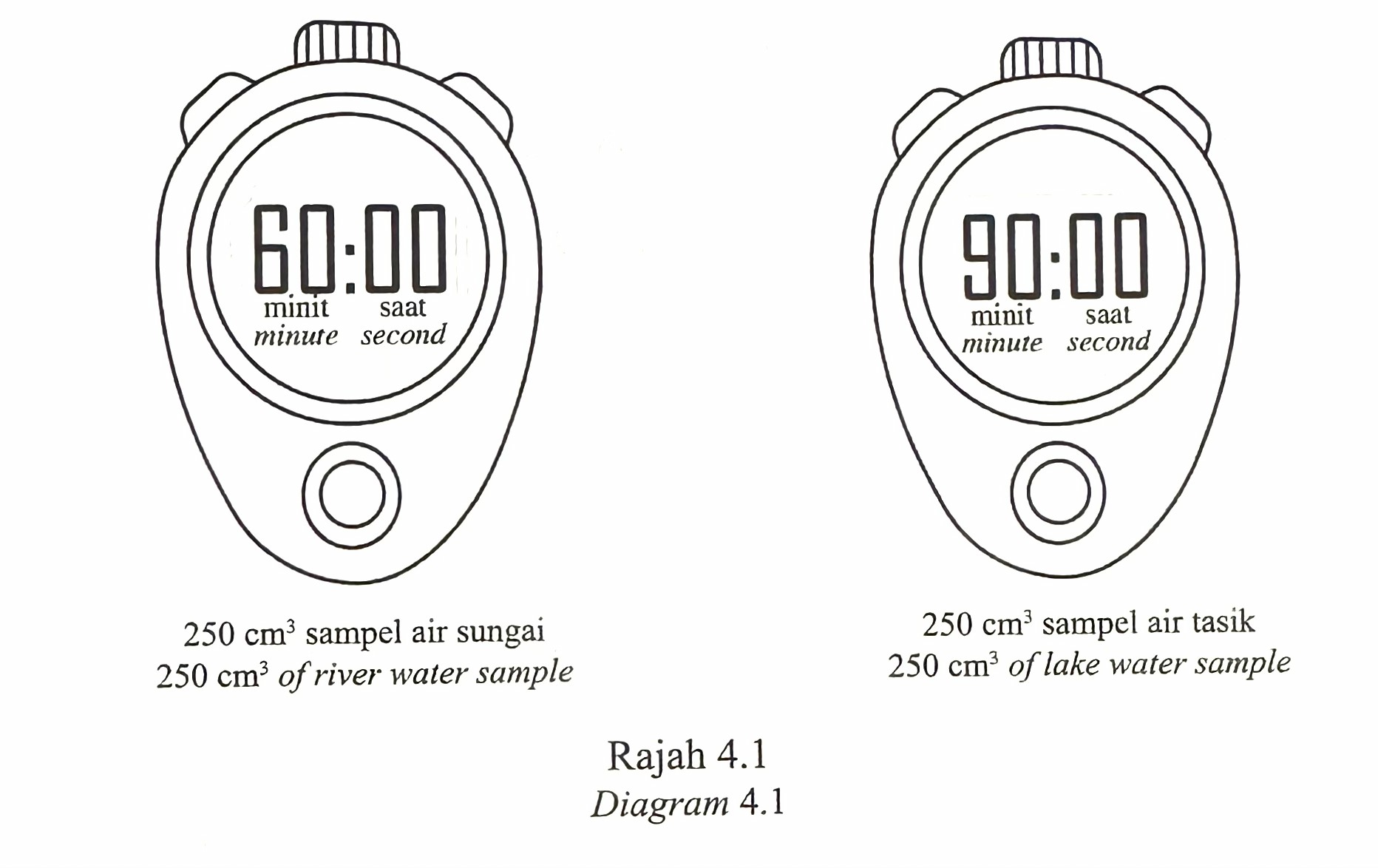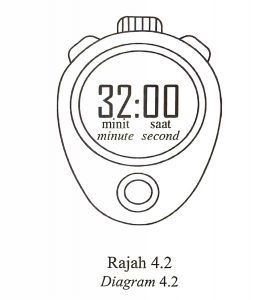Question 4:
Diagram 4.1 shows two readings of digital stopwatch for the time taken to decolourise 1 cm3 of methylene blue solution for two water samples.
 (a) Based on Diagram 4.1 state one observation for river water sample. [1 mark]
(a) Based on Diagram 4.1 state one observation for river water sample. [1 mark]
(b) State one reason for your answer in 4(a). [1 mark]
(c) State one way to control the constant variable. [1 mark]
(d) Diagram 4.2 shows the time taken to decolourise 1 cm3 of methylene blue solution for water sample M.

Based on the information in Diagram 4.1 and Diagram 4.2, arrange the water samples according to the level of water pollution in ascending order. [1 mark]
(e) The following is a statement related to the experiment.
 Based on the experiment results, state one evidence that can support the statement. [1 mark]
Based on the experiment results, state one evidence that can support the statement. [1 mark]
Answer:
(a) The time taken to decolourise the methylene blue solution in the river water sample is 60 minutes, faster than lake water sample.
Explanation:
As showed in Diagaram 4.1
(b) The time taken to decolourises methylene blue solution in a river water sample was 60 minutes due to the lower dissolved oxygen content in river water compared to lake water.
Explanation:
The river water may contain more organic matter or microorganisms that aid in the decomposition of the methylene blue solution colour more quickly compared to lake water.
(c) Use the same volume of methylene blue solution for each water sample.
Explanation:
So that the decolourisation time is only affected by the type of water sample, not by differences in the volume of methylene blue.
(d) Lake water sample → River water sample → Water sample M
Explanation:
The shorter the time taken, the higher the level of pollution. Therefore, the lake water sample, which takes 90 seconds, shows the lowest level of pollution, followed by the river water sample, and then water sample M , which shows the highest level of pollution.
(e) Lake water takes a longer time ( 90 minutes) to decolourise the methylene blue solution compared to river water ( 60 minutes).
Explanation:
The longer decolourisation time in lake water ( 90 minutes) is evidence that supports the statement: lake water is less polluted and therefore safer.
Diagram 4.1 shows two readings of digital stopwatch for the time taken to decolourise 1 cm3 of methylene blue solution for two water samples.
 (a) Based on Diagram 4.1 state one observation for river water sample. [1 mark]
(a) Based on Diagram 4.1 state one observation for river water sample. [1 mark](b) State one reason for your answer in 4(a). [1 mark]
(c) State one way to control the constant variable. [1 mark]
(d) Diagram 4.2 shows the time taken to decolourise 1 cm3 of methylene blue solution for water sample M.

Based on the information in Diagram 4.1 and Diagram 4.2, arrange the water samples according to the level of water pollution in ascending order. [1 mark]
(e) The following is a statement related to the experiment.
 Based on the experiment results, state one evidence that can support the statement. [1 mark]
Based on the experiment results, state one evidence that can support the statement. [1 mark]Answer:
(a) The time taken to decolourise the methylene blue solution in the river water sample is 60 minutes, faster than lake water sample.
Explanation:
As showed in Diagaram 4.1
(b) The time taken to decolourises methylene blue solution in a river water sample was 60 minutes due to the lower dissolved oxygen content in river water compared to lake water.
Explanation:
The river water may contain more organic matter or microorganisms that aid in the decomposition of the methylene blue solution colour more quickly compared to lake water.
(c) Use the same volume of methylene blue solution for each water sample.
Explanation:
So that the decolourisation time is only affected by the type of water sample, not by differences in the volume of methylene blue.
(d) Lake water sample → River water sample → Water sample M
Explanation:
The shorter the time taken, the higher the level of pollution. Therefore, the lake water sample, which takes 90 seconds, shows the lowest level of pollution, followed by the river water sample, and then water sample M , which shows the highest level of pollution.
(e) Lake water takes a longer time ( 90 minutes) to decolourise the methylene blue solution compared to river water ( 60 minutes).
Explanation:
The longer decolourisation time in lake water ( 90 minutes) is evidence that supports the statement: lake water is less polluted and therefore safer.